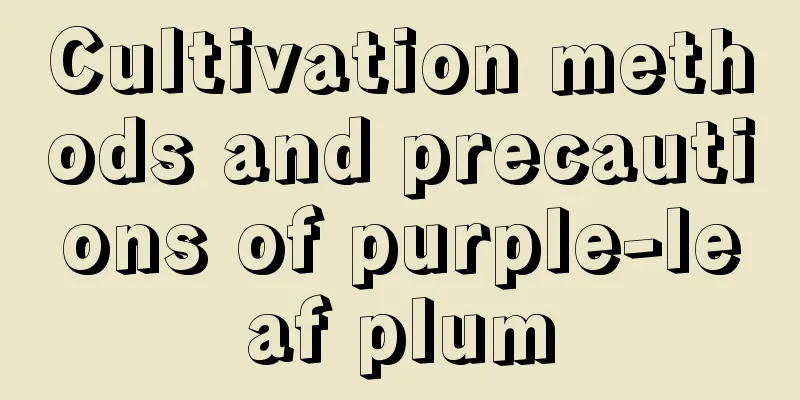Cultivation methods and precautions of purple-leaf plum

Cultivation method of purple leaf plumTemperature and lightPurple-leaf plum likes warm and humid climate, is not cold-resistant, and likes sunlight. It should be planted in a sunny place and should never be planted in the shade or under a big tree. soilPurple-leaf plum grows well in fertile, deep, well-drained, clay, neutral, and acidic soils. Generally, gravel soil is preferred, but clay soil is also acceptable. Watering and fertilizingPurple-leaf plum likes a moist growing environment and needs to be watered sufficiently during the growing period. Due to the heavy rainfall in July and August, you don't need to water the plants, and you still need to do a good job of drainage to prevent water accumulation and root rot. After entering autumn, watering must be controlled, otherwise excessive water will cause the branches to grow too long, which will easily cause frost damage in winter. Purple-leaf plum likes fertilizer. Before watering the plant every year, you can apply some farmyard manure to promote the vigorous growth of the plant. However, although purple-leaf plum has the characteristic of liking fertilizer, it only needs to be fertilized once in late autumn every year. Because if fertilizer is applied too many times or in too large an amount, the color of the leaves will easily become darker and not bright, reducing its ornamental value. Reproduction methodGenerally, three methods are used: cutting propagation, bud grafting, and aerial layering. Things to note when growing purple-leaf plumPruning workThe best tree shape for purple-leaf plum is the "sparse layered shape", and the "natural open heart shape" can also be adopted. When pruning the main branches at each layer, some side branches should be retained appropriately to make the crown fuller but not hollow. After the tree shape is basically formed, it only needs appropriate pruning every year, such as cutting off dense, drooping, overlapping and dead branches. Pest controlThe main pests are spider mites, spiny moths and bagworms The most common disease is bacterial perforation, which is widespread and serious. Once it occurs, it affects the normal growth and ornamental value of the plant and may even cause death. |
<<: Maintenance methods of lily of the valley flowering in winter
>>: When does the leek lotus bloom?
Recommend
Can azalea be repotted in summer? What are the time and precautions for repotting?
Can azalea be repotted in summer? It is not suita...
Best way to control thrips pests
Thrips , a pest that seriously threatens fruit tr...
Why does the goldfish plant lose its leaves and how to remedy it
1. Reasons for leaf drop 1. The light is too stro...
Don’t keep green ivy or money trees in the living room! How wonderful it is to grow these 3 kinds of flowers, they bloom and grow all over the branches, so festive!
1. Winter Jasmine Spring is coming soon. At this ...
How many lucky bamboos should be grown in water to attract wealth?
1. How many roots are suitable? (1) One: The best...
Cypress's growth environment and local conditions
Cypress Growth Environment and Conditions Cypress...
Will the lotus bamboo bloom?
1. Will it bloom? In fact, it doesn't bloom. ...
Asparagus cutting propagation methods and precautions
Asparagus cutting propagation method Asparagus gr...
When is the best time to transplant ginkgo trees? (The best time and precautions for transplanting ginkgo trees)
Ginkgo trees are one of the most important tree s...
Characteristics of plum blossoms, pictures of plum blossoms
1. Features 1. Tree: Plum blossoms are small tree...
Analysis of cost input and profit of rapeseed planting
Rapeseed is the main cash crop in my country'...
What fertilizer is good for sweet potato topdressing?
Sweet potato topdressing time Sweet potatoes have...
What are the cultivation methods and precautions for potted lemon trees?
How to grow a potted lemon tree Potted lemon tree...
How to fertilize Jilongyue? Timely adjustments have a good effect!
Fertilization method of Jilongyue: Spring and Fal...
How to grow eucalyptus potted plants
Eucalyptus potted plant maintenance Eucalyptus po...









